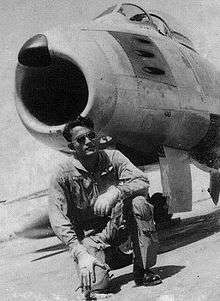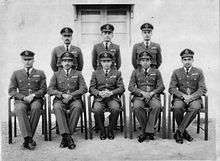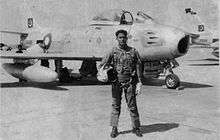Waleed Ehsanul Karim
| Flg Offr Waleed Ehsanul Karim | |
|---|---|
 Waleed Ehsanul Karim | |
| Nickname(s) | Waleed |
| Born |
July 1944 Harbang, Chakaria, Cox's Bazar, British India, Present Day Bangladesh |
| Died |
19 April 1965 Near Karachi |
| Allegiance |
|
| Service/ |
|
| Years of service | 1963 - 1965 |
| Rank |
|
| Unit | 17th Squadron (the Tigers) |
| Battles/wars | Indo-Pakistani War of 1965 |
| Signature |
|
Flying Officer Waleed Ehsanul Karim, Shaheed (Martyr) (Bengali: ওয়ালীদ এহসানুল করিম) (July 1944, Harbang, Chakaria – 19 April 1965, Karachi) was a Pakistan Air Force's fighter pilot and one of the youngest F-86 Sabre jet pilots in the entire world.[1]
Background
Karim was born in July 1944 to Fazlul Karim and Nazmunnisa Chowdhurani at Harbang, Chakaria, Cox's Bazar, British India (now in Bangladesh). He completed his Senior Cambridge from PAF Public School Sargodha (formerly PAF College Sargodha) in April 1961 (5th Entry, Sabre House) and joined the Pakistan Air Force (PAF) in August 1961.
PAF career
He was commissioned in the PAF on 22 June 1963 in the 36th GD(P) Course. He was the Wing Under Officer (WUO). He was also selected for the Sword of Honor, but did not get it. In a debate in the academy, he had mentioned the Language Movement of 1952 which compelled the government to establish Bengali at par with Urdu. He was later nominated as Pakistan Air Force basketball team captain at the Air Force Academy, Risalpur. M. Matiur Rahman, Bir Sreshtho, and Momtaz Uddin Ahmed (later air vice marshal) were his classmates in both Sargodha and Risalpur.


Fighter pilot in the PAF
After commissioning, Waleed was posted to No. 2 Squadron at Mauripur Air Base at Karachi. After successfully completing the Jet Conversion Training on T-33 jet trainers at Mauripur, he was earmarked for Fighter Conversion Training with the F-86 Sabre. Then he was posted to No. 19 Squadron in Peshawar due to his performance in the Fighter Conversion Course.
He was famous for his daring stunts with his F-86 Sabre. He took part in the Republic Day fly past at Rawalpindi on 23 March 1964.
Indo-Pakistani 1965 War
He died when his recently repaired aircraft (which was hit by anti-aircraft guns at the Rann of Kutch in a morning sortie) developed engine trouble and plunged into the Arabian sea about 10–15 miles off the south coast of Karachi in the night of 19 April 1965 as he was returning from a reconnaissance mission over Gujarat. He had participated in the Rann of Kutch battle by dropping smoke bombs in daytime to screen infantry attacks. Neither his body nor his aircraft was recovered, but a part of the rudder was later recovered from the same location two months later. At that time, he was a fighter pilot of 17th Squadron (the Tigers) of the Pakistan Air Force. Air Marshal Azim Daudpota was his squadron leader at that time.
References
- ↑ Bowman, Martin (2016-01-30). Cold War Jet Combat: Air-to-Air Jet Fighter Operations 1950-1972. Casemate Publishers. ISBN 9781473874626.